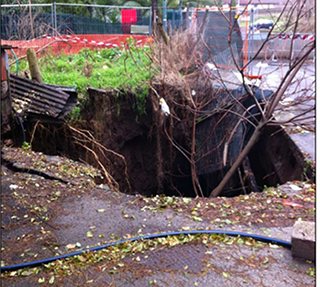
The Via Columella quarry collapse. Courtesy of G.K. Mattietti and Centro di Ricerche Speleoarcheologiche
Rome may be the “eternal city” of Italy, but sections of its roads could collapse suddenly due to the erosion of ancient underground quarries. Italian scientists are using three-dimensional laser scanning to survey the quarry tunnels to locate potential threats to the city's infrastructure.
Residents of Rome began excavating pyroclastic (volcanic) rock 2,800 years ago, and over the centuries, much of that rock has gone into masonry and mortar for the city's buildings. Rome spread out on top of the underground quarries, now 7 to 20 m under the municipal streets. Although some tunnels were reused as catacombs during the Roman Empire and as bomb shelters during World War II, successive generations of people have forgotten where many of these tunnels lie.
Unfortunately, the long-abandoned quarries can make their presence known without warning. The mass of modern multi-story buildings; road vibrations from truck traffic, leading to tiny fractures in underground utility conduits; water seepage – all are factors leading to the growing number of Roman street collapses (67 in the first half of 2013, 77 in 2012 and 44 in 2011).
Researchers from Centro di Ricerche Speleoarcheologiche (Italy) and Rome's municipal government are mapping the extent of the Roman tunnels and seeking out potential trouble spots. According to Giuseppina Kysar Mattietti, assistant professor of earth science at George Mason University (U.S.A.) and a consultant with the center, scanning the quarries with a portable, commercially available laser system reveals cracks and crevasses that the human eye might not pick up. When they find previously hidden weaknesses in underground quarries, municipal engineers can decide whether to shore up yet preserve the sagging tunnel or to fill the void with mortar.
In October, Kysar Mattietti presented detailed studies of a collapsed street known as Via Columella at the Geological Society of America's annual meeting. The team is now studying four or five additional sites in Rome. Each January, during George Mason's winter break, Kysar Mattietti also invites students to Rome, where she teaches a two-week interdisciplinary class on the archaeology, geography and anthropology of the ancient city.
